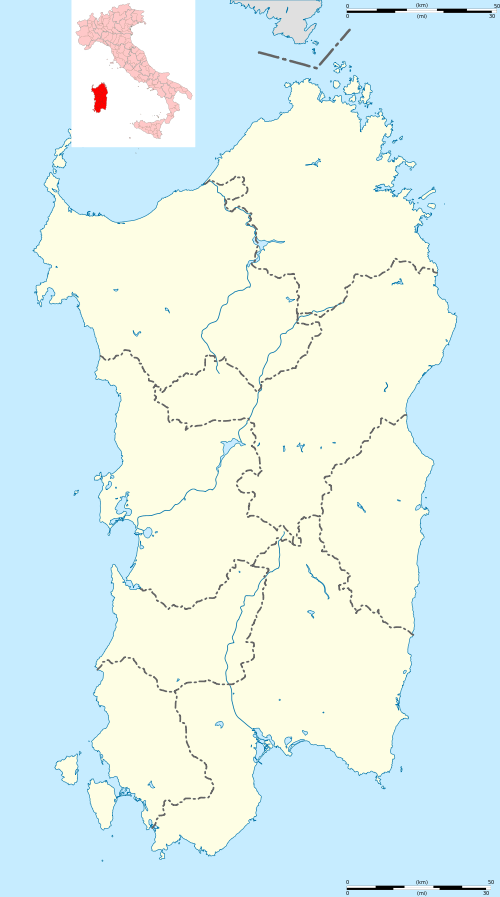Carloforte
| Carloforte U Pàize | ||
|---|---|---|
| Comune | ||
| Comune di Carloforte | ||
 | ||
| ||
 Carloforte Location of Carloforte in Sardinia | ||
| Coordinates: 39°9′N 8°18′E / 39.150°N 8.300°E | ||
| Country | Italy | |
| Region | Sardinia | |
| Province / Metropolitan city | South Sardinia | |
| Government | ||
| • Mayor | Marco Simeone | |
| Area | ||
| • Total | 50.24 km2 (19.40 sq mi) | |
| Elevation | 10 m (30 ft) | |
| Population (28 February 2015)[1] | ||
| • Total | 6,207 | |
| • Density | 120/km2 (320/sq mi) | |
| Demonym(s) | Carlofortini or Tabarkini | |
| Time zone | CET (UTC+1) | |
| • Summer (DST) | CEST (UTC+2) | |
| Postal code | 09014 | |
| Dialing code | 0781 | |
| Patron saint | St. Charles Borromeo | |
| Saint day | November 4 | |
| Website | Official website | |
Carloforte (U Pàize in Ligurian, literally: the village, the town) is a fishing and resort town of located on Isola di San Pietro[2] (Saint Peter's Island), approximately 7 kilometres (4 miles) off the southwestern coast of Sardinia, in southern Sardinia, Italy.

History
According to a legend, a local church (Chiesa dei Novelli Innocenti) was founded in the early 14th century in honour of hundreds of participants to the so-called Children's Crusade of 1212 who perished in a shipwreck just off the island on their way to North Africa during a gale. The church, called Chiesa dei Novelli Innocenti and is located within the town perimeter, is not currently used as a church (only one time in the year); it was the only evident remainder of building found at the time of colonization in 1739.
Carloforte was founded in the 18th century by some 30 families of coral fishers, originally from Pegli, near Genoa, Liguria. They had left their home town in 1541, and had settled in the island of Tabarka, off the coast of Tunisia, to fish for coral. After centuries, the coral in that area was exhausted[2] and so the families set off back to Italy and found there was plenty of coral in the sea off the west coast of Sardinia. They asked the King of Sardinia Charles Emmanuel III for permission to settle on San Pietro Island, at that time not inhabited. When he granted them permission, the island was colonized (1739); the name Carloforte (Charles the Strong, but also the Fort of Carlo) was given to the town they established there, in honour of the king. To this day Carloforte maintains strong cultural ties with the towns of Pegli and Genoa. The population still speaks a variant of Ligurian language called tabarchìn (or tabarchino, in Italian), completely different from Italian and Sardinian, is used even by most children and taught in the schools of the island.
Economy
Modern-day Carloforte's principal sources of revenue are fishing, tourism, and remittances from the many merchant mariners around the world who hail from Carloforte.
Carloforte, boasting several beaches, both rocky and sandy, is a summer tourist destination. On the other side of the island from Carloforte is a functioning lighthouse (Capo Sandalo Lighthouse, now automated), locally known simply as Il Faro and whose structure dates back to the 1880s.
Carloforte boasts a long-standing tradition of wooden boatbuilding. Locally built traditional lateen sail fishing boats (luggers) can be spotted in the harbour.
To the north of the town (at the La Punta locale) is a collection of buildings that housed the former communally owned tuna-processing plant linked to the once-vibrant tuna fishing tonnare industry on the island. Some of the buildings have undergone renovation to some extent and now contain wind-surfing school and a new, privately owned tuna processing business. Some of the buildings are still in ruins, but remain of great architectural interest.
Education
The town hosts a maritime high school.
Transportation
Ferry services connect the port of Carloforte with the Sardinian mainland at Portovesme as well as Calasetta, a similar fishing port on Sant'Antioco Island.
Twin towns – Sister cities
 Tabarca, Spain
Tabarca, Spain Metropolitan City of Genoa, Italy
Metropolitan City of Genoa, Italy Pegli, Italy
Pegli, Italy Camogli, Italy
Camogli, Italy Montecchio Maggiore, Italy from 2009
Montecchio Maggiore, Italy from 2009
References
- ↑ All demographics and other statistics: Italian statistical institute Istat.
- 1 2
 Chisholm, Hugh, ed. (1911). "Carloforte". Encyclopædia Britannica (11th ed.). Cambridge University Press.
Chisholm, Hugh, ed. (1911). "Carloforte". Encyclopædia Britannica (11th ed.). Cambridge University Press.
External links
| Wikimedia Commons has media related to Carloforte. |
| Wikisource has the text of the 1911 Encyclopædia Britannica article Carloforte. |
- Carloforte e l'Isola di San Pietro (Italian)
- Official regional website (English)
- Sardinia guide (English)
